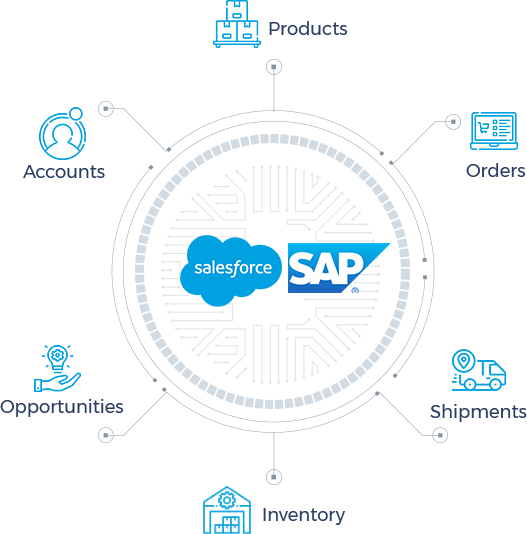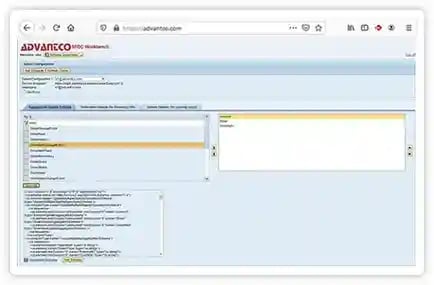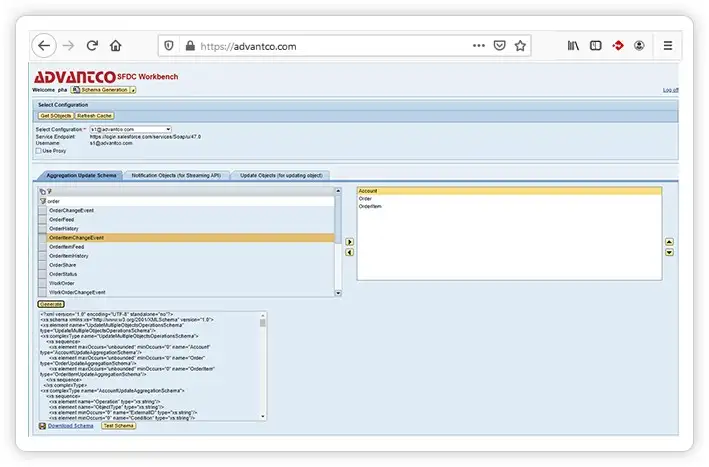Streamline Workflows with Salesforce SAP Integration using Advantco
Automate two-way data flows and empower sales and support with 360-degree visibility into opportunities, accounts and orders. Integrate faster with an SAP Salesforce adapter/connector that scales to your needs.
.png)
SAP to Salesforce Integration
SAP Salesforce Integration to Streamline Workflows
Master data sync
Update Customers, Accounts, Products or Price Books in real-time or via batch process.
Opportunity-to-order
Convert a Salesforce opportunity into an SAP order or quote and send back to Salesforce to generate a contract.
Order-to-cash
Empower Sales with full visibility into order status, shipping, invoicing and accounts receivable.


Advantco SAP to Salesforce Key Capabilities
 Security
Security
- Authenticate with User Session ID, 0Auth 2.0 or two-way SSL.
 Configuration
Configuration
- Support standard or custom objects with any Salesforce API - SOAP, REST, Bulk, Streaming - or with custom SOAP and REST APEX APIs.
- Enable real-time Platform Events and Outbound Messaging.
- Test queries and generate schemas with Advantco Workbench.
 Monitoring
Monitoring
- Enable enhanced error handling and bulk message monitoring.
 Supported platforms
Supported platforms
- All SAP PI/PO versions from 7.3 to 7.5.
- Cloud Integration (part of SAP Integration Suite)
Integration flows
 Outbound
Outbound
Empower Sales and Support with real-time updates on orders, shipments and invoices to Salesforce. Simplify customer migrations and mass product and pricing changes with batch updates.
 Inbound
Inbound
Simplify quotations and orders with real-time opportunity sync into SAP. Join and query Salesforce objects with SOQL, call custom APEX services, & push custom events with Platform Events and Outbound Messaging.
SAP to Salesforce Integration Demo

Top 5 features
 Security
Security
- Two way SSL/TLS connectivity provides higher access security which verifies that request is coming from Salesforce organization
 Efficiency & Ease of Use
Efficiency & Ease of Use
- Channel communication is dynamic, where one channel can switch between Salesforce APIs reducing time consuming integration steps
- Automatic pagination of large SOQL-SOSL seamlessly which helps reducing time consuming and code-heavy integration steps
- Data batching mechanism automatically splits large payload into series of smaller messages which reduces time-consuming and heavy coding
 Web-based Workbench
Web-based Workbench
- Bring the rich experience by using responsive web design principles and provides an optimal viewing and interaction experience.
- Module is included in the bundle deployment file, no other deployment steps.
- Don't have to install any tools such as Eclipse plugins.
- Manage the defined connections to Salesforce tenants and reuse them in iFlows
Integrating SAP and Salesforce : Advantages and Considerations
 Point-to-Point Integration:
Point-to-Point Integration:
Establishing direct connections between specific modules or functions in SAP and Salesforce offers flexibility but can become intricate and challenging to manage with increasing integrations.
 Enterprise Service Bus (ESB):
Enterprise Service Bus (ESB):
An ESB is a central hub for integrating various applications, including SAP and Salesforce. It provides a standardized interface for data exchange and simplifies integration management.
 Cloud Integration Platforms (iPaaS):
Cloud Integration Platforms (iPaaS):
Cloud-based iPaaS solutions offer pre-built connectors, drag-and-drop interfaces, and scalability, making them a popular choice for cloud-based applications like SAP and Salesforce.
Benefits of Integrating SAP and Salesforce
 Enhanced Data Quality
Enhanced Data Quality
By eliminating manual data entry, integration ensures consistent and accurate data across both systems, minimizing errors and enhancing decision-making processes.
 Improved Operational Efficiency:
Improved Operational Efficiency:
Streamlined data exchange automates business processes, reduces errors, and saves time, allowing employees to focus on higher-value tasks. This can lead to increased productivity and cost savings.
 Enhanced Customer Experience:
Enhanced Customer Experience:
A unified view of customer data enables personalized interactions, faster issue resolution, and improved customer satisfaction. This can lead to increased customer loyalty and revenue growth.
 Increased Visibility and Decision-Making:
Increased Visibility and Decision-Making:
Consolidated data gives managers real-time insights into sales performance, customer trends, and inventory levels. This enables informed decision-making and improved business outcomes.
Advantco vs. SAP Salesforce Adapter
-


-
Switch between Salesforce APIs
-
-
-
Connection - Two way SSL/TLS
-
-
-
SOQL SOSL - Automatically pagination mechanism, Update Trigger
-
-
-
SOQL after Streaming API / OBM Message
-
-
-
Data batching mechanism on Receiver channel
-
-
-
Web-based Workbench
-
-
SAP to Salesforce Integration: A Definitive Guide
Modern enterprises often use both SAP and Salesforce. SAP serves as an organization’s backbone, consolidating its logistics, sales, finances, and business operations into one location. As a CRM, Salesforce facilitates sales in a customer-friendly way.
To get the best from both systems, integration is essential. With a tight integration between SAP and Salesforce, your enterprise will gain key insights and growth opportunities, while increasing the reliability of both systems. (Of course, any integration effort must cater to your organization’s specific needs and use case.)
In this guide, we’ll introduce you to the many benefits of integrating SAP and Salesforce, and we’ll step through the different integration approaches available to your organization.
Why an SAP and Salesforce integration makes sense
Maintaining two systems of record is hard. You have to continually reconcile the systems and watch for a variety of issues. Fortunately integrating SAP and Salesforce breaks down these silos for better operational efficiency. Let’s consider some of the additional advantages.
Accurate real-time data
Without proper integration, data is delayed or siloed between systems. Consider this example of a siloed system: Suppose a customer requests confirmation of a Proof of Concept (PoC) trial payment, and the information is not updated manually across both systems. This will lead to confusion and delayed task initiation, eroding customer interest.
Real-time data accurately synchronized across SAP and Salesforce brings the following benefits:
● Up-to-the-moment preparedness for any customer interaction
● Immediate responsiveness to changes in an Opportunity or Account
● Prompt maintenance of your workflows and actions, with no data update blockers
Cross-platform synchronization
Without cross-platform synchronization, an enterprise must invest considerable resources into keeping the two systems up to date or determining which system is correct. This leads to errors, miscommunication, and lost productivity.
For example, consider what might happen when adding a customer contact via SAP. You notice the entry doesn’t match the information you have in Salesforce. One system is wrong, and rectifying the data conflict will consume valuable time and effort.
Data synchronization reduces confusion and wasted time by:
● Enabling the free flow of information between the two systems.
● Ensuring data integrity between the two systems by establishing a single source of truth.
● Alleviating the need for manual double-checking or re-entry of data.
Workflow automation
Beyond being just systems of record, SAP and Salesforce are also systems that perform actions. Without integration, your workflows will be disconnected, resulting in blocks and errors.
For example, imagine you are onboarding a new customer. In Salesforce, you have a workflow rule to perform a credit check, while in SAP you have a rule to send an NDA. With disconnected systems, onboarding customers will be a cumbersome, multi-step, and error-prone process. Fragmented workflows can introduce significant missteps that may cost you customers.
Proper automation between systems ensures your SAP workflows seamlessly connect to your Salesforce system, reducing errors and increasing workflow efficiency across both systems.
Scalability
With siloed systems, as more business processes populate two separate and disconnected systems, the challenges will likewise increase. Customer life-cycle complexities (such as certifications or international regulations), onboarding new customers, and contract renewals for current customers will become lengthier processes. In addition, you’ll have more inventory, workflows, and data overall. When systems are siloed, exciting business growth can be eclipsed by data-reconciliation hassles.
Navigating these complexities while working with disconnected systems will quickly bring an enterprise to its limits of scale. To scale well, you need a performant system to handle more customers, data, and complicated contracts. You need integrated systems.
Now that we’ve looked at the benefits of integrating SAP with Salesforce, let’s look at the main decision all organizations must consider when it comes to integration.
Integration approaches: build versus buy
When pursuing an integration, every enterprise faces the “build versus buy” question. Should you build a custom integration adapter or buy one built by a third party? Let’s consider the advantages and disadvantages of the approaches.
Build a custom solution in-house
The main advantage of building a custom adapter is that you gain complete control over the integration as it pertains to your business. However, this comes at a cost. Disadvantages include:
● Significant task complexity, as SAP and Salesforce are not simple systems.
● Dedication of engineering resources to build the integration.
● Sourcing the proper expertise to build the integration.
● Maintaining the integration.
● Uncertainty around the custom solution’s ability to scale as the organization grows.
Buy a pre-built adapter
On the other hand, enterprises may consider buying an adapter built by third parties with deep expertise in SAP, Salesforce, and systems integrations. The advantages of this approach include:
● Less time is needed to achieve a valuable integration.
● Task complexity and build expertise are offloaded to experienced and skilled experts.
● Adapter maintenance and updates are handled by your provider.
● Higher confidence in your ability to scale, as the solution is often already tested and used at scale.
Of course, we should not overlook the disadvantages of buying a pre-built adapter:
● Higher up-front cost
● Possibility of a less customizable solution than a bespoke adapter.
Building an in-house, custom adapter is a substantial financial and engineering commitment. Unless your business use case necessitates an in-house solution, pre-built adapters likely provide more advantages. In addition, pre-built adapters are regularly serviced and tested, making them more reliable options.
Whichever approach you choose, planning for a successful integration is crucial.
Key considerations for a successful integration
To achieve a successful integration, keep the following key practices in mind:
● Plan now to support scalability and future growth. You may have only a dozen customers now, but you want the ability to support thousands of customers (and beyond) seamlessly. Don’t let your future growth be stymied by myopic planning now.
● Ensure security and compliance by protecting data integrity. Make sure your integration adapter transfers data securely between SAP and Salesforce.
● Test your integration thoroughly to avoid unexpected issues as you roll out to production and increase the volume of data and workloads.
● Involve all relevant stakeholders to ensure the integration will meet everyone’s needs.
If you decide on a pre-built adapter, you’ll find two primary options. Let’s first consider the adapter offered by SAP.
One option: SAP’s Salesforce adapter
SAP provides a Salesforce adapter within the SAP Cloud Integration and SAP Integration Suite license. SAP’s adapter offers the following:
● Subscription to events from Salesforce
● Supporting CRUD operations to Salesforce
● Support for the Salesforce Object Query Language (SOQL)
● Support for the Salesforce Object Search Language (SOSL)
This solution is best suited for organizations that can invest significant time and resources into their integration. These organizations will likely need in-house experts to oversee the project.
Despite its benefits, the adapter from SAP has some limitations and challenges, such as:
● Cannot switch between different Salesforce APIs
● Operates using a one-way connection that is not SSL-encrypted
● Lacks automatic pagination for Salesforce queries and searches
● No support for trigger updates
● Does not support the streaming API for SOQL
● No option to batch data on a receiver channel
● Limited operational support from experts, offers only standard SAP technical support
Enterprises using SAP’s Salesforce adapter may run up against its limited scalability. Not having an encrypted connection could be a red flag for security auditors. Scalability and security issues cause many organizations to lament their original choice and pursue an alternative solution.
Given the investment of time and money required for an integration, it’s important to select a suitable adapter the first time around.
A better option: The Salesforce Adapter from Advantco
Advantco’s SAP Salesforce Adapter is up to date with the most recent Salesforce APIs and features. Its differentiating features include:
● Enhanced efficiency by switching between Salesforce APIs as needed
● Support for Salesforce’s Pub/Sub API, allowing for event-driving integrations
● Strong security (User Session, OAuth 2.0, two-way SSL/TLS Connection), ensuring worry-free compliance audits
● SOQL and SOSL pagination
● Regular updates to ensure compatibility with the latest Salesforce edition and API version
● Support for update triggers
● Fully automated migration from SAP’s Salesforce adapter
● An easy-to-set-up, web-based workbench to manage Salesforce connections and reuse them in SAP iFlows.
● Readily accessible support (responses within hours) from integration experts with deep knowledge of SAP and Salesforce integrations.
● Available for the SAP Integration Suite and SAP Process Orchestration
● Augments the SAP Migration Tool to support the migration from SAP Process Orchestration to SAP Integration Suite
Advantco’s adapter—which has a low upfront cost—can help your enterprise complete your integration between SAP and Salesforce within four to eight weeks. The integration is simple and has very few moving pieces. Unlike its SAP counterpart, integration through Advantco’s adapter doesn’t require in-house platform specialists.
SAP supports protocols like HTTP and SOAP to work with its process orchestration, but these require custom solutions for proper integration. Advantco’s adapter is the only solution that natively supports SAP Process Orchestration.
The maintenance cost is significantly reduced as Advantco maintains and updates the integration. Advantco also provides a proof of concept trial period to let customers try the adapter before buying it.
Conclusion
Integrating SAP and Salesforce ensures your business is efficient and your personnel effective. Enterprises have two possible integration approaches—build or buy—though for many enterprises, buying is preferable.
Although SAP provides an adapter, Advantco’s SAP Salesforce Adapter is the strongest choice for an SAP + Salesforce integration. To learn more about what Advantco’s adapter can do, you can read case studies that show how businesses saved time and money with the solution. Alternatively, contact Advantco directly.
FAQ’s
SAP to Salesforce integration connects two popular enterprise applications, SAP ERP and Salesforce CRM, to enable seamless data exchange between them. This integration helps businesses streamline workflows, improve customer visibility, and enhance operational efficiency.
Yes, it is possible to integrate SAP and Salesforce, and many organizations choose to do so to streamline business processes and enhance overall efficiency. Both SAP and Salesforce are widely used enterprise software solutions, and integrating them can provide a unified view of data and processes across various departments.
- Streamlined workflows: Automate data exchange between SAP and Salesforce, eliminating manual data entry and reducing errors.
- Master data sync: Keep customer, account, product, and pricing information consistent across both systems.
- Opportunity-to-order: Convert Salesforce opportunities into SAP orders or quotes, and send back order confirmations to Salesforce.
- Order-to-cash: Gain real-time visibility into order status, shipping, invoicing, and accounts receivable
- Lock for Security: Secure connections with User Session ID, OAuth 2.0, or two-way SSL.
- Configuration: Support standard or custom Salesforce objects using any API (SOAP, REST, Bulk, Streaming) or custom APEX APIs.
- Monitoring: Advanced error handling and bulk message monitoring.
- Supported platforms: All SAP PI/PO versions from 7.3 to 7.5 and SAP Cloud Integration Suite.
- Switch between Salesforce APIs: Dynamically switch between Salesforce APIs to reduce integration complexity.
- Two-way SSL/TLS connectivity: Enhance security with two-way SSL/TLS verification.
- SOQL/SOSL automation: Automatically handle pagination and update triggers for SOQL/SOSL queries.
- Data batching: Automatically split large payloads into smaller messages for efficient processing.
- Web-based workbench: User-friendly web interface for managing connections and configurations.
- Trusted by leading enterprises: Proven track record with large and sophisticated companies.
- Schedule a discovery call with Advantco to discuss your specific requirements.
- Contact Advantco for more information and pricing.
- Implement the Advantco Salesforce Workbench to streamline your SAP to Salesforce integration processes.
Ready to learn more?
We're happy to answer all of your questions.
.png)
.png)



